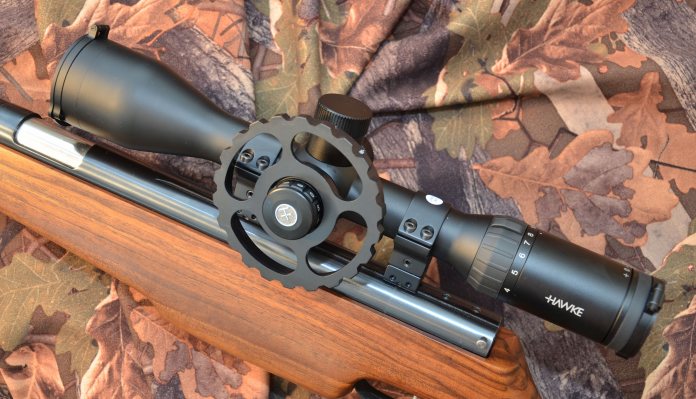Hawke Airmax 30 4-16x50 SF FFP IR
-
0
 Comments
Comments
- Last updated: 01/02/2024

The Airmax range of scopes from Hawke Optics has been with us for some time now, and on test here is one of the very latest – the Airmax 30 4-16x50 SF FFP IR. For those new to the game, let’s just nail the basics. 30 relates to the body tube being the larger 30mm; magnification is variable from 4x up to a useful 16x; 50 denotes an objective lens of 50mm; SF specifies ‘side focus’; FFP refers to First Focal Plane; and IR stands for illuminated reticle.
Personal taste
At this point, it’s important to spell out the significance of FFP. First Focal Plane effectively means the scope has been constructed with the reticle positioned in front of the magnifying lens, and this means that the target stays in proportion to the reticle, even as the magnification is altered. The reticle appears smaller in the image as the mag is wound down, and larger as it is increased, which can be disconcerting for those unfamiliar with the FFP spec. However, the benefit is that the reference/aim points remain constant, irrespective of the magnification selected. Specific application and personal taste will dictate play here, but FFP is definitely gaining ground.
What’s included?
Hawke supplies the Airmax in a protective carton, and alongside the scope, there’s a 4” side wheel, lens cap adjuster tool, lens cloth, spare battery, sunshade, Allen keys, and various instruction booklets, covering optically centring the scope, turret information, reticle specification, mounting, zeroing, and maintenance. It’s all very comprehensive and provides the punter with everything needed to get started.
Initial set-up
This scope came fitted with flip-up metal lens caps, and I’m really not a fan of these as they just seem crude. Undoubtedly, they do their job, but they can work loose. Also, the first task with any optic is to set the fast focus dioptre on the rear ocular lens, to establish both a clear target and crisp reticle picture at the same time. Once this is done, the rear lens cap will almost certainly be sitting off to one side and will need to be removed, and the carrier position inside the tube reset with the semi-circular tool provided, to get everything in line. Give me push-fit rubber versions every time.
Parallax SF
As mentioned, the Airmax features side focus, adjusted via the left turret. Target distances are marked on the turret, from 10 yards, then 15, 20, 30, 50, 100, 200, 500, and infinity. Hawke uses a simple push friction fit with the 4” side wheel, so just line up the corresponding distances (and the indents) and push the wheel into position. Using a wheel is deemed to be more accurate for range finding, as it extends the arc of adjustment, although at the relatively low magnification here, it’s largely academic, but it enhances feel.
The turret was initially very stiff, but with the wheel attached, it all loosened up and worked smoothly. Personal eyesight can affect how a scope suits the individual, and on the test, 25 yards as a measured distance parallaxed to 15 yards on the dial. No great problem, simply add a sticky label with personal distances marked off as necessary.
Zeroing
Metal screw caps protect the turrets, and with these removed, zeroing could begin. Click values are 1/10 MRAD and movement is positive and audible. This model also features turret rotation indicators, which are handy when dialling in longer-range shots, giving an instant visual indicator as to where the turret sits within its range of adjustment.
Interestingly, I tested this same Airmax specification in an older version back in 2014, and for the record, the field of view has now increased by some 9ft at 100 yards when viewed on a maximum 16x magnification, so the ‘Wide Angle’ label is clearly justified. This latest version is also some 8oz lighter, although, at 26.6oz, it still represents a significant addition to many rigs.
Image reference
The AMX reticle is neat and precise. With the equidistant layout and Mil-Dot values, a perfect example of an application here is viewing an HFT 15mm target zone at 25 yards while bracketed within two dots. The outer hollow borders help to bracket the overall reticle image, but the visuals still suffer from a lack of dark borders to help location and tracking in poor light, or dark foliage – the downside of Hawke’s design. Many shooters favour illumination, and here that’s powered by a single battery that’s housed in the cap of the left turret. The tip of the left turret serves as the rheostat, and here there are six levels of brightness, and alternate ‘off’ stages. Utilise this feature and the central area and dots all illuminate in red. FFP means the reticle reduces in size to around one-sixth of the diameter of the image when viewed on the lowest 4x mag. Wind up to 16x, and the reticle fills to around three-quarters of the image. Edge-to-edge clarity is very impressive, and everything feels well thought out and nicely presented.
Verdict
As alluded to, this is quite a heavy scope, so that needs to be borne in mind. If that’s not an issue, then there’s plenty to tip the balance in its favour. Hawke specifies it as nitrogen-purged, shockproof, waterproof, fogproof, and all calibre rated, and with a ‘no fault lifetime warranty’ also part of the deal, the whole process should be stress-free.
At £429, this optic seems fair value too, and with a high standard of build, and a versatile specification, it should provide years of trouble-free service.
Reticle
AMX
Weight
26.6oz
Eye Relief:
3.5"
Click Values
1/10 MRAD
Field of View
32.5-8ft @ 100 yards
Body Tube
30mm
Minimum Focus
10 Yards
Length
13.7"
Clicks Per Rotation
60
Number of Rotations
4.75 on windage and 5 on elevation
Price
£429
Contact
Hawke Sport Optics - www.hawkeoptics.com
